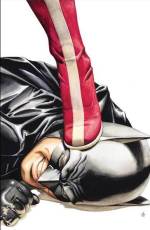| View previous topic :: View next topic |
| Author |
Message |
faceless
admin

Joined: 25 Apr 2006
|
 Posted: Thu Aug 23, 2007 12:24 am Post subject: did ancient Ethiopians rule India? Posted: Thu Aug 23, 2007 12:24 am Post subject: did ancient Ethiopians rule India? |
 |
|
|
|
Ancient African Kings Of India
By Dr. Clyde Winters
Ethiopians have had very intimate relations with Indians. In fact, in antiquity the Ethiopians ruled much of India. These Ethiopians were called the Naga. It was the Naga who created Sanskrit. A reading of ancient Dravidian literature which dates back to 500 BC, gives us considerable information on the Naga. In Indian tradition the Naga won central India from the Villavar (bowmen) and Minavar (fishermen). The Naga were great seamen who ruled much of India, Sri Lanka and Burma. To the Aryans they described as half man and snake. The Tamil knew them as warlike people who used the bow and noose.
The earliest mention of the Naga, appear in the Ramayana , they are also mentioned in the Mahabharata. In the Mahabharata we discover that the Naga had the capital city in the Dekkan, and other cities spread between the Jumna and Ganges as early as 1300 BC. The Dravidian classic, the Chilappathikaran made it clear that the first great kingdom of India was Naganadu. The Naga probably came from Kush-Punt/Ethiopia. The Puntites were the greatest sailors of the ancient world. In the Egyptian inscriptions there is mention of the Puntite ports of Outculit, Hamesu and Tekaru, which corresponds to Adulis, Hamasen and Tigre.
In Sumerian text, it is claimed that the Puntites traded with the people of the Indus Valley or Dilmun. According to S.N. Kramer in The Sumerians, part of Punt was probably called Meluhha, and Dilmun was probably the ancient name of the Indus Valley. (Today some scholars maintain that Oman, where we find no ancient cities was Dilmun and the Indus Valley may have been Meluhha).
Ancient Ethiopian traditions support the rule of Puntites or Ethiopians of India. In the Kebra Nagast, we find mention of the Arwe kings who ruled India. The founder of the dynasty was Za Besi Angabo. This dynasty according to the Kebra Nagast began around 1370 BC. These rulers of India and Ethiopia were called Nagas. The Kebra Nagast claims that ” Queen Makeda “had servants and merchants; they traded for her at sea and on land in the Indies and Aswan”. It also says that her son Ebna Hakim or Menelik I, made a campaign in the Indian Sea; the king of India made gifts and donations and prostrated himself before him”. It is also said that Menalik ruled an empire that extended from the rivers of Egypt (Blue Nile) to the west and from the south Shoa to eastern India”, according to the Kebra Nagast. The Kebra Nagast identification of an eastern Indian empre ruled by
the Naga, corresponds to the Naga colonies in the Dekkan, and on the East coast between the Kaviri and Vaigai rivers.
The presence of Meluhhaites/ Puntites in India may expain the Greek tradition of Kusites ruling India up to the Ganges. It would also explain the Aryan traditions of Mlechchas ( Sanskrit name for some of the non-Aryan people) as one of the aboriginal groups of India. Many scholars associate the name Mlechchas with Meluhha.
The major Naga tribes were the Maravar, Eyinar, Oliyar, Oviyar, Aru-Valur and Parathavar. The Nagas resisted the invansion of the Cholas. In the Kalittokai IV,1-5, the Naga are described as being “of strong limbs and hardy frames and fierce looking tigers wearing long and curled locks of hair.” The Naga kings of Sri Lanka are mentioned in the: Mahawanso, and are said to have later become Dravidians, as testified to by the names of these people: Naganathan, Nagaratnam, Nagaraja and etc.
The major gift of the Naga to India was the writing system: Nagari. Nagari is the name for the Sanskrit script. Over a hundred years ago Sir William Jones, pointed out that the ancient Ethiopic and Sanskrit writing are one and the same.
William Jones, explained that the Ethiopian origin of Sanskrit was supported by the fact that both writing systems the writing went from left to right and the vowels were annexed to the consonants. Today Eurocentric scholars teach that Indians taught writing to the Ethiopians, yet the name Nagari for Sanskrit betrays the Ethiopia origin of this form of writing. Moreover, it is interesting to note that Sanskrit vowels: a,aa,’,I,u,e,o, virama etc., are in the same order as Geez.
The Ethiopian script has influenced many other writing systems. Y.M. Kobishnor, in the Unesco History of Africa, maintains that Ethiopic was used as the model for Armenian writing, as was many of the Transcaucasian scripts. Dravidian literature indicate that the Naga may have introduced worship of Kali, the Serpent, Murugan and the Sun or Krishna. It is interesting to note that a god called Murugan is worshipped by many people in East Africa.
It is interesting that Krishna, who was associated with the Sun, means Black, this is analogous to the meaning of Khons of the Kushites. Homer, described Hercules as follows: “Black he stood as night his bow uncased, his arrow string for flight”. This mention of arrows identifies the Kushites as warriors who used the bow, a common weapon of the Kushites and the Naga.
Kumarinadu
The Naga or Ethiopians were defeated by Dravidian speaking people from Kumarinadu. Kamarinadu is suppose to have formerly existed as a large Island in the India ocean which connected India with East Africa. This landmass is mentioned in the Silappadikaram, which said that Kamarinadu was made up of seven nadus or regions. The Dravidian scholars Adiyarkunallar and Nachinaar wrote about the ancient principalities of Tamilaham, which existed on Kamarinadu.
Kumarinadu was ruled by the Pandyans/Pandians at Madurai before it
sunk beneath the sea. The greatest king of Kumarinadu was Sengoon.
According to Dravidian scholars the Pandyans worshipped the goddess Kumari Amman. This Amman, probably corresponds to the ancient god Amon of the Kushites.
The Kalittokai 104, makes it clear that after the Pandyans were forced to migrate off their Island home into South India, “to compensate for the area lost to the great waves of the sea, King Pandia without tiresome moved to the other countries and won them. Removing the emblems of tiger (Cholas) and bow (Cheras) he, in their place inscribed his reputed emblem fish (Pandia’s) and valiantly made his enemies bow to him
For more info and writings about and from Dr Clyde Winters click HERE
--------------------------------------------------------------------------------
Fascinating stuff I thought. |
|
| Back to top |
|
 |
eefanincan
Admin

Joined: 29 Apr 2006
Location: Canada
|
 Posted: Thu Aug 23, 2007 11:27 am Post subject: Posted: Thu Aug 23, 2007 11:27 am Post subject: |
 |
|
|
|
| Interesting..... I really know nothing of this time in history so it was very informative. |
|
| Back to top |
|
 |
Skylace
Admin

Joined: 29 Apr 2006
Location: Pittsburgh, PA
|
 Posted: Thu Aug 23, 2007 12:36 pm Post subject: Posted: Thu Aug 23, 2007 12:36 pm Post subject: |
 |
|
|
|
| This is an interesting read for sure. I am going to have to look up some more about this and do some more reading. |
|
| Back to top |
|
 |
Twirley

Joined: 29 Apr 2006
Location: North Carolina
|
 Posted: Thu Aug 23, 2007 4:16 pm Post subject: Posted: Thu Aug 23, 2007 4:16 pm Post subject: |
 |
|
|
|
That was interesting. There is so much about that whole area that is not ordinarily known in the western world. I find it fascinating...like Sky, I'll be off researching and reading some more.
Thanks for stimulating our minds, Face! |
|
| Back to top |
|
 |
Skylace
Admin

Joined: 29 Apr 2006
Location: Pittsburgh, PA
|
 Posted: Thu Aug 23, 2007 4:36 pm Post subject: Posted: Thu Aug 23, 2007 4:36 pm Post subject: |
 |
|
|
|
| One of the things I do love about history is the things like this. We can never be positive exactly what happened. So finding out these new tidbits makes it more fun to find out more. |
|
| Back to top |
|
 |
|
|
|
|
You cannot post new topics in this forum
You cannot reply to topics in this forum
You cannot edit your posts in this forum
You cannot delete your posts in this forum
You cannot vote in polls in this forum
You cannot attach files in this forum
You cannot download files in this forum
|
Couchtripper - 2005-2015
|


